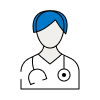Gallstones are solid lumps or "stones" which form in the gallbladder or bile duct. They are formed when some of the chemicals stored in the gallbladder harden. They may be as tiny as a grain of sand or as big as a golf ball, and resemble small stones or gravel. Some people get just one large stone, others may have hundreds of tiny ones. Having gallstones is not uncommon. It may be present in 10% of the population, and usually without symptoms. Only if they begin to obstruct the bile system do problems such as infection and inflammation begin.
The gallbladder
The gallbladder is a small bag-shaped organ on the right hand side of your body, just below the rib cage. It stores a green liquid called bile, which is produced by the liver to help the body digest fats and other substances. When we eat, bile is released from the gallbladder into the intestines through a narrow tube called the bile duct.
Causes of gallstones
Bile is made up of water, cholesterol, other fats, bile salts and a pigment called bilirubin. Gallstones form when the usual balance of these substances is upset.
There are two types of gallstones:
- Cholesterol gallstones are the most common, accounting for about 80% of cases. These are formed when there is too much bilirubin or cholesterol in the bile, or not enough bile salts. They may also occur when the gallbladder does not empty as it should. Cholesterol gallstones are usually yellowish green.
- Pigment stones are small and dark and made of bilirubin. Their cause is uncertain although they tend to develop in people who suffer from liver disease, bile tract infections or hereditary blood disorders such as sickle-cell anaemia.
The factors that contribute to getting gallstones include:
- Obesity – a major factor, especially in women.
- Excess oestrogen, one of the female sex hormones, from pregnancy, oral contraceptive pills or hormone replacement therapy (HRT).
- Gender - women aged 20 to 60 are twice as likely as men to develop gallstones.
- Age – people over 60 are at higher risk.
- Cholesterol-lowering drugs. These decrease the amount of cholesterol in the blood but increase the amount of cholesterol in the bile.
- Diabetes – this causes high levels of fatty acids which increase the risk of gallstones.
- Rapid weight loss – causes the liver to secrete extra cholesterol.
- Fasting – decreases gallbladder movement.
Symptoms of gallstones
Sometimes, gallstones cause no symptoms at all. These are called ""silent stones"" and require no treatment.
The most common symptoms produced by gallstones are:
- Abdominal pain that can become severe, lasting from 30 minutes to several hours
- Pain under the right shoulder or between the shoulder blades
- Nausea
- Vomiting
These tend to occur after a fatty meal or during the night. Other symptoms may include abdominal bloating, gas, and indigestion.
Serious symptoms that need immediate medical consultation are:
- Yellowing of the skin or the whites of the eyes
- Sweating
- Chills
- Fever
- Dark urine and pale clay-coloured stools
Diagnosis of gallstones
Sometimes gallstones, especially ""silent stones"", are found by chance during tests for other problems. If stones are suspected, doctors can perform a variety of tests to identify them:
- Ultrasound - soundwaves are used to create images of the internal organs and pinpoint the location of any stones.
- Imaging with iodine - an iodine pill is given the night before the test, or an injection of special iodine dye, which makes the biliary system show up on X-ray images.
- ERCP (Endoscopic retrograde cholangiopancreatography) - a long, flexible, telescope with a light at the end is guided through the mouth and down through the stomach into the small intestine. This enables the doctor to view the ducts directly and locate any stones.
- Blood and/or urine tests - these may be used to check for signs of infection and inflammation.
Treatment of gallstones
SurgeryPeople can live healthily without a gallbladder, and the most common treatment for problem gallstones is surgical removal of the gallbladder. There are several surgical options:
- Laparoscopic cholecystectomy (keyhole surgery). This is the most common treatment. After a general anaesthetic, a number of tiny cuts, usually four, are made in the abdomen, through which surgical instruments and a miniature video camera are inserted. The gallbladder is removed without cutting through any abdominal muscles, and if necessary, ERCP (see above) can be used to locate and remove stones in the bile duct. Keyhole surgery causes less pain and fewer complications than surgery involving larger cuts in the abdomen.
- Open surgery. Sometimes, keyhole surgery is not possible and an ""open"" cholecystectomy is necessary. This involves the removal of the gall bladder under general anaesthetic through a cut in the abdomen.
- The operation is generally safe, and for most people the benefits are greater than the disadvantages. However, all surgery does carry some risk. The most common complication in gallbladder surgery is damage to the bile ducts, which may require additional surgery.
Other treatment optionsIn special situations (for example, if a patient cannot be given an anaesthetic), non-surgical treatment of stones may be necessary. One approach is to use medicines to dissolve the stones, but this treatment is not suitable for everyone and may take a very long time. Another approach, extracorporeal shock wave lithotripsy (ESWL), uses shock waves to break up the stones into tiny pieces that can then pass easily out of the system. However, attacks of intense colic pain are common after ESWL and the success rate is not high.
Prevention of gallstones
Factors that reduce the risk of getting gallstones include:
- Maintaining normal weight and avoiding fasts or very low-calorie diets
- Taking regular vigorous exercise
- Eating a diet rich in vitamin C
- Two or three cups of coffee per day may lower the risks for men. However, the benefits and risks of caffeine intake vary from individual to individual.
Disclaimer
This information was published by Bupa Group's Health Content Team and has been reviewed by appropriate medical or clinical professionals. To the best of their knowledge the information is current and based on reputable sources of medical evidence, however Bupa (Asia) Limited makes no representation or warranty as to the completeness or accuracy of the Content.
The information on this page, and any information on third party websites referred to on this page, is provided as a guide only. It should not be relied upon as a substitute for professional medical advice, nor is it intended to be used for medical diagnosis or treatment. Bupa (Asia) Limited is not liable for any loss or damage you suffer arising out of the use of, or reliance on, the information.
Third party websites are not owned or controlled by Bupa and any individual may be able to access and post messages on them. Bupa is not responsible for the content or availability of these third party websites. Last updated August 2017.









